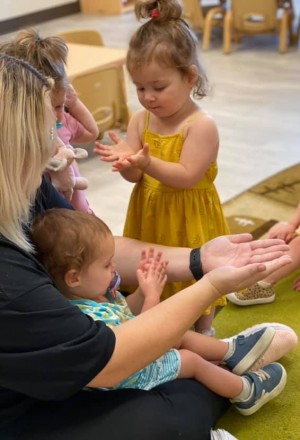
Why Multicultural Education Matters
In the United States, researchers have found that approximately 23% of students in the educational school systems are from immigrant households (Csillik, 2020). In early childhood preschool classrooms, about a quarter of children are multilingual learners (NAEYC, 2024). According to 4th grade reading assessment data in 2022 taken by the National Assessment of Educational Progress, examination of the average test scores across diverse ethnic groups determined that English language learners (ESL) and students from black or Hispanic backgrounds performed at a lower level on these tests than students who were white or Asian. Further research shows that introducing multicultural education in early childhood helps young children grow, especially as they start learning about who they are and how to build relationships with others. It supports their social and emotional development in meaningful ways (Colarusso & O'Rourke, 2010). Therefore, early education classrooms should prepare children early on, through exposure to a multi-language approach, which uses linguistically diverse strategies to support the learning curriculum.
At Children’s Lighthouse, we see this as an opportunity for our families. That is why we have enriched our learning environments and daily lesson activities with basic Spanish words and Sign Language components integrated into our curriculum, to support all children from linguistic and diverse learning backgrounds.
- How Language Plays a Role - Using different languages in the classroom helps children build vocabulary and understand the world around them. This is especially helpful for bilingual children who are learning in more than one language.
- Creating Inclusive Classrooms - Teaching in ways that are fair and inclusive ensures that every child feels seen, valued, and supported, no matter their background or culture.
- Supportive School Environments - Schools that build strong, respectful communities and focus on fairness and social responsibility make a big difference in helping all families feel welcome and empowered (Ogletree & Lake, 2010).
The Power in The Benefits
Having opportunities for your children to explore multiculturalism concepts and be exposed to diverse languages through Spanish and Sign Language is beneficial for multiple reasons.
- It allows your child to be connected to real-life learning experiences through language that reflects them personally.
- It supports meeting the child’s linguistic skills and communication abilities.
- It fosters a sense of community and builds a culture of diverse learning within a social classroom in both content and context, which supports all children’s ability to use and receive a variety of verbal and non-verbal language representations.
- Exposure to rich-language environments has been shown in studies to enhance your child’s brain cognition, vocabulary skills, and reading comprehension.
- It celebrates you! Incorporating multicultural approaches in education supports all families’ backgrounds and linguistic needs by offering enrichment opportunities that reflect your child’s primary spoken language between school and home.
How We Support a Multi-Language Approach at Children’s Lighthouse
This is why, at Children’s Lighthouse, we intentionally incorporate multiculturalism, Spanish, and Sign Language into our curriculum lessons, activities, and learning environments. Using our proprietary Lighthouse CARES® curriculum, teachers guide children through multicultural learning experiences in our Centers That Shine curriculum materials, which are designed with diverse themes and offer a variety of cultural representations through pictures and concepts. We encourage children to explore and play with real-life and multicultural items, as these enhance the learning environment. Integrated into our Lesson Plans, we have incorporated two curriculum enrichments, Spanish words and Sign Language. Spanish is offered to support the weekly theme, which is focused on a specific word, aligning with the learning concepts and alphabet letters of the week. This same weekly word is supported by a Sign Language visual, which supports non-verbal language development. The weekly Spanish and Sign Language words are available as a visual poster displayed on The Learning Wall for children to view and learn about during teacher-led instruction. The multi-language approach, as described in our curriculum enrichments, offers diverse communication strategies for teaching and learning purposes.
What Our Families Can Do at Home
At home, families can help nurture this same spirit of diversity and multi-linguistic approach to increasing language skills and communication for their children. Studies have shown that when teachers and schools support families and children using linguistic diversity, while maintaining English language proficiency, and they offer multicultural approaches integrated into the curriculum enrichment, children benefit academically, socially, and emotionally (NAEYC, 2024). At Children’s Lighthouse, we value this and are here to support you!Here are some activities you can do with your children at home to support a multi-language approach:
- Songs and Rhymes in Multiple Languages: Sing nursery rhymes or lullabies in different family languages.
- Storytime in Different Languages: Read books in the home language and in the community language.
- Language-Rich Conversations: Use different languages during everyday routines, such as meals, bath time, walks, etc. Encourage children to express themselves in both languages.
- Cultural Cooking Sessions: Cook traditional recipes while discussing ingredients and steps in the heritage language. Talk about where the food comes from and why it’s special.
- Language Games: Play games like memory matching with pictures and words in two languages.
- Label the Environment: Label household objects (e.g., door, table, window) in multiple languages with sticky notes. Help kids connect spoken words with written language.
We believe that every child is filled with diversity and uniqueness. At the core of our Curriculum Philosophy Statement, all children deserve a safe environment that allows them to be expressive, independent learners as they develop in their own learning style. That is why we believe in the values of Connection, Confidence, Continuous Improvement, Comprehensive Curriculum, and Consistency. According to early childhood experts, your child’s development benefits when schools and teachers use different tools, multiculturalism, and create a rich learning environment that reflects and respects language differences (NAEYC, 2024). These small steps reinforce what your children are learning in school to be culturally competent and help to create stronger Home to School connections.

